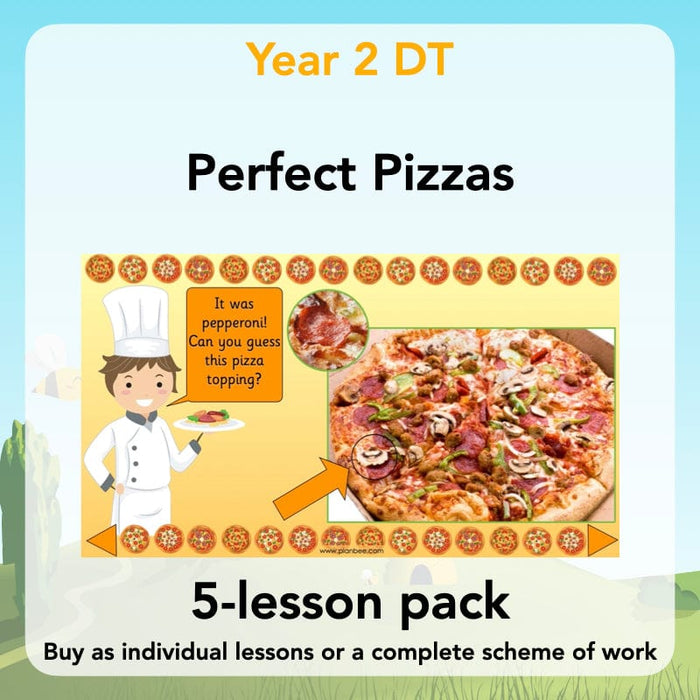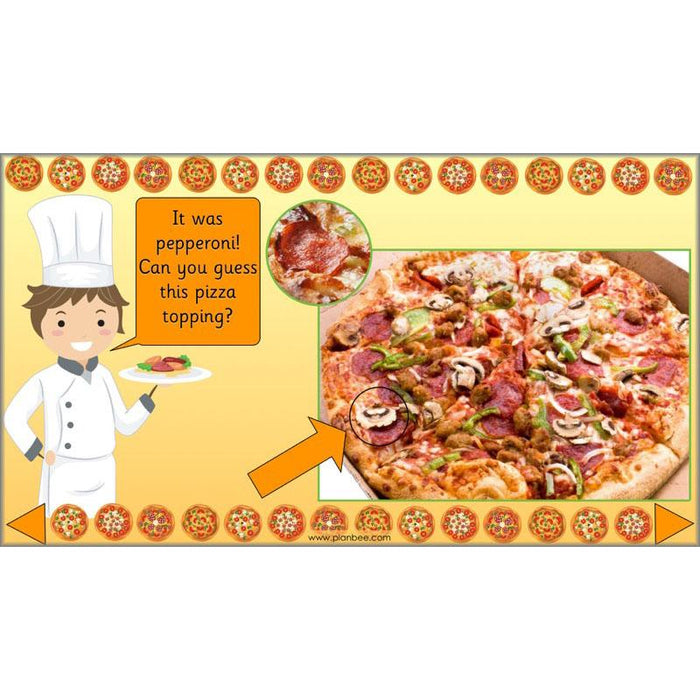#TheCompleteSeries5lessons
With lesson plans, informative slides, differentiated worksheets, Picture Cards and more, these Year 1 'Perfect Pizzas' lessons are the perfect recipe for your DT teaching!
#Lesson1Whatsyourfavouritepizza
The first lesson in this series begins by identifying pizzas and a variety of toppings that the children are familiar with. Your class will be introduced to the balanced plate and begin to think about why the food has been grouped in a particular way and what the size of each group could mean. Then they will either sort the components of their favourite pizza onto a balanced plate or gather data to create a pictogram showing who likes which pizzas best.
This downloadable lesson comes with a lesson plan, a slideshow presentation and printable teaching resources.
What's included:
- Lesson plan
- Slides
- Activity ideas
- Differentiated worksheets
- Pizza sheet
- Balanced plate
#Lesson2ExploringBreads
The second lesson in this DT perfect Pizzas series of lessons starts by asking the children to name and describe breads in terms of their taste, appearance, smell and texture. Your class will then have the chance to explore different breads for themselves by tasting, touching, looking and smelling so that they can use adjectives to describe what they have found out. Alternatively your class can match different bread pictures to clues and organise them in order of preference. During the plenary your class will begin to think about the purpose of the base of a pizza and reevaluate their breads with this in mind.
This downloadable lesson includes a lesson plan, a slideshow presentation and printable teaching resources.
What's included:
- Lesson plan
- Slides
- Activity ideas
- Differentiated worksheets
- Name cards
- Picture cards
- Clue cards
#Lesson3ExploringToppings
The third lesson in this DT perfect Pizzas series of lessons asks the children to name and describe a variety of pizza toppings in terms of their taste, appearance, smell and texture. Your class will then sort pizza toppings based on if they come from a plant or an animal and answer questions about how they have sorted them. Alternatively your class will have the chance to explore some different toppings for themselves by tasting, touching, looking and smelling so that they can use adjectives to describe what they have found out. They will also begin to think about eating a varied diet over the course of a week, comparing two characters' weekly dinners.
This downloadable lesson includes a lesson plan, a slideshow presentation and printable teaching resources.
What's included:
- Lesson plan
- Slides
- Activity ideas
- Differentiated worksheets
- Topping cards
#Lesson4RecipeDesigns
This fun DT lesson gives your class the chance to design and plan a healthy pizza. They will need to think about which toppings to use, how they will prepare them for eating and how to arrange them to make them look appetising. As an alternative to designing their pizza your class can write instructions so their pizza can be made again by other people.
This downloadable lesson includes a lesson plan, a slideshow presentation and printable teaching resources.
What's included:
- Lesson plan
- Slides
- Activity ideas
- Differentiated worksheets
- Word bank
#Lesson5LetsEat
The final lesson in this DT Perfect Pizzas series allows your class to follow their designs or instructions to make their healthy pizzas. They will then have the chance to eat their pizzas before evaluating how well they think they did and if they met the design brief.
This downloadable lesson includes a lesson plan, a slideshow presentation and printable teaching resources.
What's included:
- Lesson plan
- Slides
- Activity ideas
- Differentiated worksheets
Free Overview (Medium-Term Plan)
Download a free overview to support your teaching of this scheme of work.
Free Assessment Grid
Download a free, editable assessment grid to support your teaching of this scheme of work.
Curriculum Objectives covered
- KS1 - design purposeful, functional, appealing products for themselves and other users based on design criteria
- KS1 - generate, develop, model and communicate their ideas through talking, drawing, templates, mock-ups and, where appropriate, information and communication technology.
- KS1 - select from and use a range of tools and equipment to perform practical tasks [for example, cutting, shaping, joining and finishing
- KS1 - select from and use a wide range of materials and components, including construction materials, textiles and ingredients, according to their characteristics
- KS1 - explore and evaluate a range of existing products
- KS1 - evaluate their ideas and products against design criteria
- KS1 - use the basic principles of a healthy and varied diet to prepare dishes
- KS1 - understand where food comes from

























































